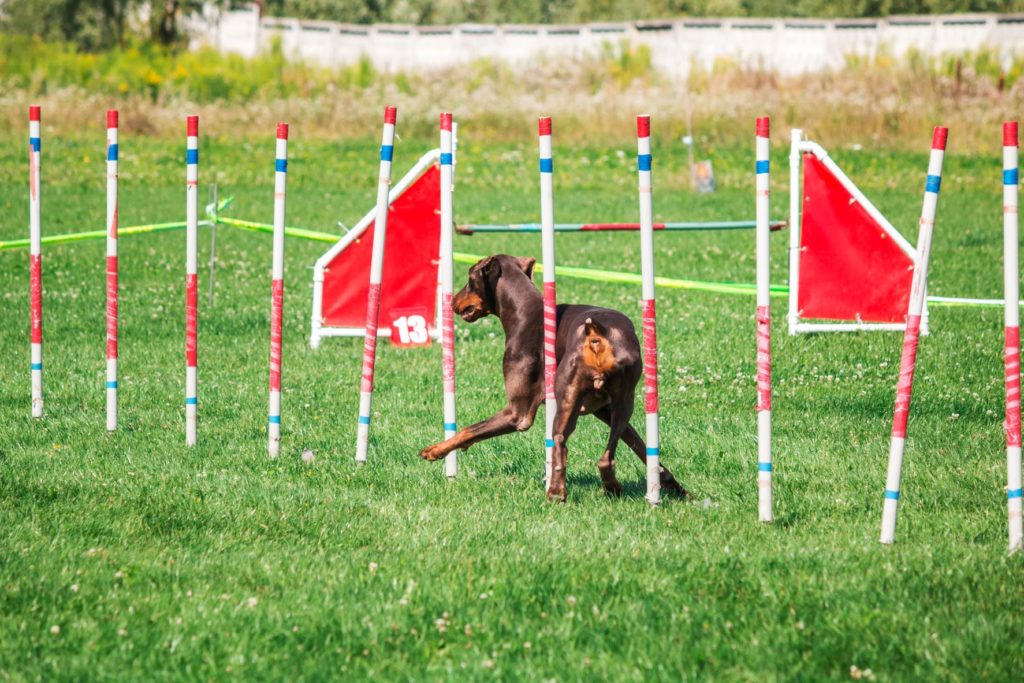
Dog agility weave poles can be tough to teach, but once your dog gets the hang of this agility obstacle, they adore zipping in and out of the poles and on to the next obstacle. At Carlson Agility, we can provide you with quality weave pole sets and some helpful facts and advice about this equipment.
1. Agility Weave Skills Mimic Instinctive Behavior
While it’s true that ancient dogs didn’t dash through a tire jump or deftly navigate a teeter, dog agility equipment is meant to provide dogs with the type of exercise they might have encountered dashing through a forest or over hills and dales chasing prey.
The weave poles might represent how dogs in ancient times might have had to dash around trees in a crowded forest chasing a rabbit. A tunnel could represent those same dogs scampering under piles of leaves in search of a tasty morsel. The teeter could be just like an unsteady fallen log crossing a bubbling brook.
At any rate, practicing the weaves, handling jumps, scampering across a dog walk and managing other types of agility equipment provides dogs with a great source of exercise and allows them to utilize that instinctive behavior.
2. It’s Not Just About Weaving
While weaving in and out of weaves correctly is crucial for a good score, the way a dog enters and exits the weave set also is important. Dogs are meant to enter the weave poles to the right of the first pole with the pole next to the dog’s left shoulder. Teaching proper entry and exit is all part of the game.
3. Conditioning Is Essential
The type of repetitive motion required for navigating weaves can take its toll on your dog’s neck and spine. One of the best ways to prevent injury is through proper conditioning. Just as with any athlete, warming up those muscles before a practice session can help to prevent injuries. Strengthening exercises and stretching also can help build your dog’s core strength and ensure that muscles are in good shape.
Spend about five minutes warming up before a weave training session. You might start with some stretching exercises and a short walk to get the muscles warmed up. After you finish training, a few more stretches and a bit of walking around can help muscles cool down. Be sure your dog has plenty of water on hand, as well, so that they don’t become overheated or dehydrated.
4. Weave Regulations Are Similar Throughout Organizations
When it comes to dog agility competitions, most of the organizations that host these contests use nearly identical types of equipment. With weaves, it’s almost universally consistent, and virtually all courses will include a set of 12 poles spaced 24 inches apart. That’s good news for handlers and trainers because it means that no matter which organization you select, training for the weaves should be identical.
5. Our Weave Poles Are Competition Quality
One of the best ways to ensure safety is by using the same type of high-quality weaves that are used on competition courses. We build each weave set by hand using the highest quality components, and our weaves are precisely what you would find on any agility course.
Tips For Weave Pole Success
Weaves have the reputation for being the toughest obstacle to teach but using the 2×2 method can make it much easier for your dog to understand how to navigate through the weave poles.
Start out with just six poles and place them 24 inches apart. Rather than starting them out in a straight line, move three of the polls to create a sort of path and just start by having your dog (possibly on a lead) walk through the path. As you pass each pole, give a command, such as the word “weave.”
Once your dog can move through the six poles off-leash with the handler at a slight distance, start to decrease the space between the poles, bringing them closer and closer together until they form a straight line. Obviously, this will take more than one training session, but eventually, your dog will be able to move in and out of the poles correctly. Once your dog has mastered the skill, you can upgrade to 12 poles and, after they master a full set, you can work on speed.
Another option would be to start with our training weaves and add guide wires to the weaves to help your dog stay on the correct path. Our training weaves can be used for 2×2 training, so if you prefer this method, you will have both options available. We also have a training weave chute, and these weaves can be separated easily to create a path or chute and you can begin closing the gap as your dog’s skills evolve. With dog agility weave poles, patience is the best virtue a handler can possess as it does take time for dogs to master this skill. In addition to weaves, we have every piece of dog agility training equipment you might need including dog agility a-frames, an agility dog walk, dog agility teeter totters, the pause table and all types of jumps, including the tire jump. If you have any questions about our weaves or any of our equipment, don’t hesitate to contact us at any time.





